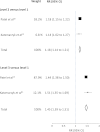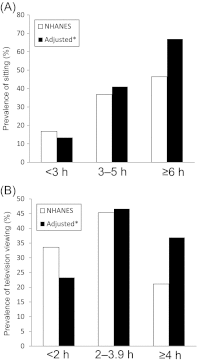Sedentary behaviour and life expectancy in the USA: a cause-deleted life table analysis
- PMID: 22777603
- PMCID: PMC3400064
- DOI: 10.1136/bmjopen-2012-000828
Sedentary behaviour and life expectancy in the USA: a cause-deleted life table analysis
Abstract
Objectives: To determine the impact of sitting and television viewing on life expectancy in the USA.
Design: Prevalence-based cause-deleted life table analysis.
Setting: Summary RRs of all-cause mortality associated with sitting and television viewing were obtained from a meta-analysis of available prospective cohort studies. Prevalences of sitting and television viewing were obtained from the US National Health and Nutrition Examination Survey.
Primary outcome measure: Life expectancy at birth.
Results: The estimated gains in life expectancy in the US population were 2.00 years for reducing excessive sitting to <3 h/day and a gain of 1.38 years from reducing excessive television viewing to <2 h/day. The lower and upper limits from a sensitivity analysis that involved simultaneously varying the estimates of RR (using the upper and lower bounds of the 95% CI) and the prevalence of television viewing (±20%) were 1.39 and 2.69 years for sitting and 0.48 and 2.51 years for television viewing, respectively.
Conclusion: Reducing sedentary behaviours such as sitting and television viewing may have the potential to increase life expectancy in the USA.
Conflict of interest statement
Figures



References
-
- US Department of Health and Human Services 2008 Physical Activity Guidelines for Americans. US Department of Health and Human Services; www.health.gov/paguidelines (accessed 10 May 2012).
-
- Thorp AA, Owen N, Neuhaus M, et al. Sedentary behaviors and subsequent health outcomes in adults a systematic review of longitudinal studies, 1996–2011. Am J Prev Med 2011;41:207–15 - PubMed
-
- Bauman A, Ainsworth BE, Sallis JF, et al. The descriptive epidemiology of sitting: a 20-country comparison using the International Physical Activity Questionnaire (IPAQ). Am J Prev Med 2011;41:228–35 - PubMed
LinkOut - more resources
Full Text Sources
